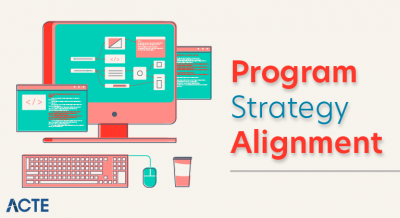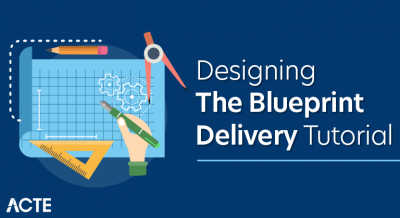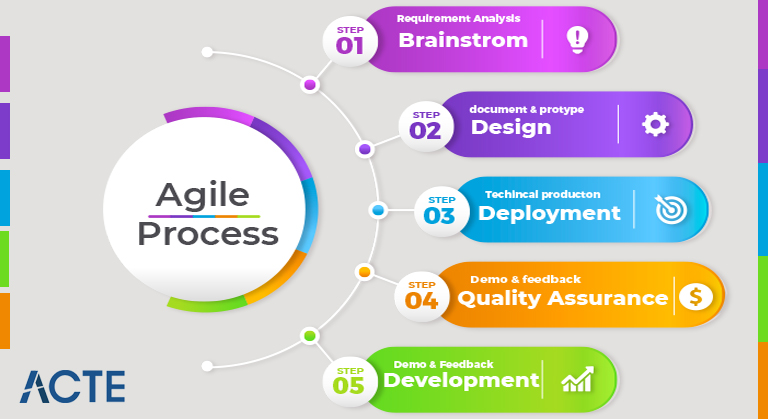
- Introduction to Understanding Agile Process
- Understanding Agile Methodologies and Principles
- History of Agile
- Agile Methodologies
- Agile Principles
- Agile comprises of four Core principles
- Features of Agile
- What is the Scope of Agile?
- Risk of Automation in Agile Process
- Advantage of Agile Methodology
- Disadvantage of Agile Methodology
- Pre-Requisites
- Conclusion
- Individuals and co operations over cycles and devices
- Working programming over extensive documentation
- Customer Agile effort over agreement exchange
- Responding to change over sticking to the script
- The second period of the Agile testing procedure is Construction Iterations, most of the testing happens during this stage. This stage is seen as a bunch of emphases to construct an addition of the arrangement. To do that, inside every emphasis, the group executes a crossover of practices from XP, Scrum, Agile displaying, spry information, etc.
- In development emphasis, the Agile group follows the focus on necessity practice: With every cycle, they take the most fundamental prerequisites staying from the work thing stack and execute them.
- The development cycle is arranged into two, corroborative testing and insightful testing. Corroborative testing focuses on checking that the framework satisfies the expectation of the partners as depicted to the group to date, and is performed by the group. While the analytical testing identifies the issue that the corroborative group has skipped or disregarded. In Investigative testing, the analyzer decides the expected issues as deformity stories. Insightful testing manages normal issues like incorporation testing, load/stress testing, and security testing.
- Again for, corroborative testing there are two viewpoints designer testing and spry acknowledgment testing. The two of them are robotized to empower consistent relapse testing all through the lifecycle. Corroborative testing is the light-footed likeness testing to the particular.
- Light-footed acknowledgment testing is a mix of conventional practical testing and customary acknowledgment testing as the advancement group, and partners are doing it together. While engineer testing is a blend of conventional unit testing and customary assistance mix testing. Engineer testing checks both the application code and the information base blueprint.
- Computerized UI gives a significant degree of certainty; however, they are delayed to execute, delicate to keep up with, and costly to construct. Computerization may not fundamentally further develop test efficiency except if the analyzers know how to test
- Problematic tests are a main pressing issue in robotized testing. Fixing bombing tests and settling issues connected with weak tests should be the main concern to stay away from bogus up-sides
- Assuming the computerized test are started physically rather than through CI (Continuous Integration) then, at that point, there is a gamble that they are not consistently running and subsequently may cause fizzling of tests
- Computerized tests are not a swap for exploratory manual testing. To acquire the normal nature of the item, a combination of testing types and levels is required
- Numerous monetarily accessible computerization instruments give basic elements like mechanizing the catch and replay of manual experiments. Such an instrument empowers testing through the UI and prompts an innately weak and hard to keep up with tests. Likewise, putting away experiments outside the form control framework makes pointless intricacy
- To save time, many times the mechanization test plan is ill-conceived or impromptu which brings about the test coming up short
- A test set up and destroy strategies are typically passed up a great opportunity during test computerization while performing manual testing, a test set up and destroy methodology sounds consistent
- Efficiency measurements, for example, various experiments made or executed each day can be frightfully deceptive and could prompt making an enormous interest in running futile tests
- Individuals from the dexterous computerization group should be compelling experts: agreeable, helpful, and creative, or this framework will rapidly fall flat
- Robotization might propose and convey testing arrangements that require a lot of progressing support compared with the worth gave
- Mechanized testing might come up short on the aptitude to imagine and convey viable arrangements
- Computerized testing might be fruitful to the point that they run out of significant issues to address, and in this manner go to immaterial issues.
- The clients persistently get a look and feel of the task progress toward the finish of every cycle/run.
- Each run furnishes the client with functioning programming which measures up to their assumptions according to the meaning of done given by them.
- The improvement groups are very receptive to the changing prerequisites and can oblige changes even in the high-level progressive phases.
- There is steady two-way correspondence which keeps the clients in question, along these lines all partners – business and specialized – have clear perceivability on the venture’s advancement.
- The plan of the item is productive and satisfies the business necessities.
- In this manual to assist you with understanding Agile, we covered various subjects like the cascade model, its detriments, what is Agile, Agile standards, benefits, and approaches.
- Think you want more skilling up to do? You can look at Sampliner’s Agile Scrum Master Certification Training Course. We cover how Agile can be carried out in the course, unique Agile approaches, scrum ideas, and substantially more exhaustively. The course will likewise upgrade your capacity to create and convey quality items to clients.
Introduction to Understanding Agile Process:
Agile a Tutorial a few times called Agile technique. This instructional exercise contains fundamental and progressed ideas of dexterity. Our Agile instructional exercise is intended for amateurs and experts. Agile is an iterative methodology of programming advancement procedure utilizing a short emphasis of 1 to about a month. Utilizing the Agile technique, the product is appropriated with the quickest and fewer changes. The benefits of the Agile procedure are consumer loyalty by the quick, constant turn of events and conveyance of helpful programming.
What is Agile: Understanding Agile Methodologies and Principles:
What is Agile?
Agile is an assortment of standards utilized in programming advancement and undertaking the board. Dexterous spotlights in empowering groups to convey work in little, functional augmentations, hence conveying worth to their clients effortlessly. Assessment of the necessities, plans, and results happen consistently. This helps the group in reacting to changes in a speedy way.The significant standards of Agile are nitty-gritty in the Agile proclamation. Made in mid-2001, the Agile proclamation subtleties the various qualities and rules that encapsulate the cycle. The declaration states:
What is how you might interpret Agile?
Agile is an iterative way to deal with a project the executives and programming improvement that assists groups with conveying worth to their clients quickly and with fewer migraines. Necessities, plans, and results are assessed constantly so groups have a characteristic instrument for reacting to change rapidly.
What is a scrum in Agile?
Scrum is a system of rules, jobs, occasions, and curios used to execute Agile tasks. It is an iterative methodology, comprising of runs that ordinarily simply last one to about a month. This approach guarantees that your group conveys a variant of the item routinely.
History of Agile:
1. Agile was conceived when on one fine day when 17 individuals with various improvement systems foundation, got together to conceptualize assuming there was a potential elective answer for programming advancement which could prompt quicker advancement time and was less documentation weighty.
2. Around then, programming advancement used to happen so long that when tasks were fit to be conveyed, the business had pushed forward and the prerequisites had changed. Along these lines, a task couldn’t meet the business needs regardless of whether it had the option to meet its characterized goals.
3. Accordingly, these heroes of various computer programming strategies got together and the outcome of their gathering was what they called the “dexterous proclamation’ which we will examine exhaustively in the following instructional exercise of this series.
4. However, the dexterous that was conceived that day isn’t what we see today in associations. The procedure those specialists settled upon was portrayed as ‘lightweight’ and quick. Yet, the primary success out of this gathering was the possibility that quicker conveyance of an item and consistent input were the keys to making progress in programming improvement.
5. The current cascade methods were excessively lumbering and had no arrangement for input until the eventual outcome was fit to be conveyed. This intended that there was no extension for course amendment and the client had no view on the advancement until the entire item was prepared. Also, that was what these specialists needed to stay away from. They needed an answer which would have scope for consistent input to keep away from the expense of revising at a later stage.
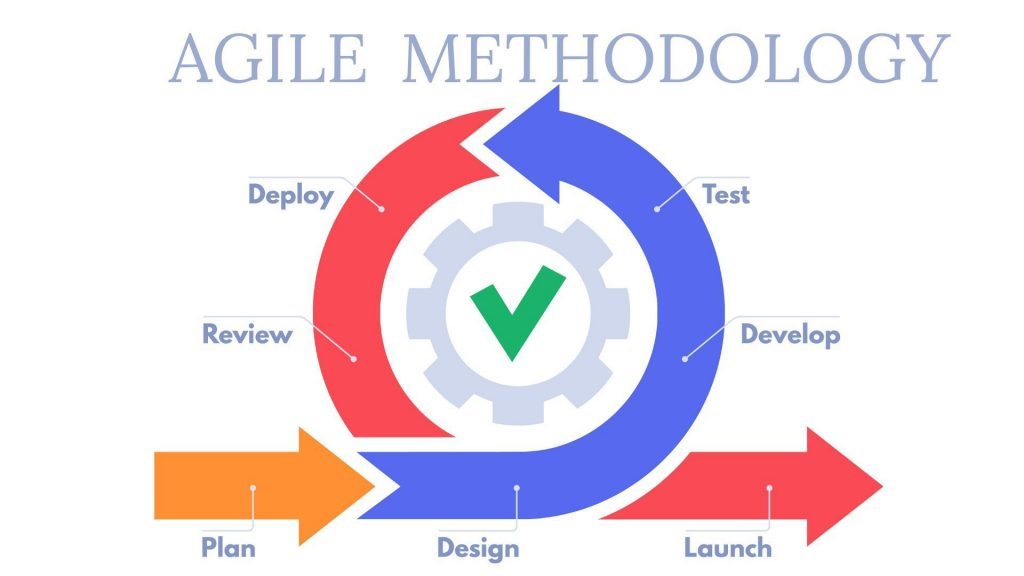
Agile Methodologies:
1. Outrageous Programming:
It is a structure that empowers groups to make excellent programming that works on their satisfaction. It empowers programming advancement close by suitable designing practices. It is appropriate while taking care of changing programming necessities gambles caused because of new programming, working with a little, broadened improvement group, and innovation that permits computerized unit and useful tests.
2. Kanban:
It is a strategy that is utilized to configure, make due, and work on the progression of frameworks. Kanban empowers associations to envision their progression of work and breaking point how much work is underway. It is utilized in circumstances where work shows up unusually, and where it should be conveyed quickly without hanging tight for other work things.
3. Lean:
It is a bunch of apparatuses and rules that spotlights recognizing and eliminating waste to accelerate process improvement. Esteem is expanded, and squander is limited. It is utilized in pretty much every industry that produces squander in some structure.
4. Scrum:
It is a structure utilized by groups to lay out speculation, test it, consider the experience, and adapt. It empowers groups to fuse rehearses from different systems relying upon the prerequisites. It is utilized by cross-useful groups that are chipping away at item advancement, and the work is parted into more than one 2-multi week cycle.
5. Precious stone:
It centers around individuals and their cooperations, rather than on devices and cycles. Intended to smooth out processes and further develop enhancement, Crystal deals with the rule that tasks are extraordinary and dynamic. It is utilized when the attention is in reinforcing group correspondence, constant incorporation, dynamic client association, and configurable cycles.
Agile Principles:
To make an interaction Agile, the accompanying standards should be fulfilled.
1. Consumer loyalty: The client should be happy with the fast conveyance of the item.
2. Welcome Change: Indeed, even late in the improvement interaction, changing requirements should be tended to.
3. Convey Frequently: Zero in on a more limited timescale and guarantee items are conveyed habitually.
4. Cooperate: The business and advancement group needs to cooperate through the course of the venture.
5. Spurred Team: Colleagues should be spurred and trusted to finish the venture effectively and on schedule.
6. Up close and personal: Having up close and personal collaborations is one of the best types of correspondence.
7. Working Software: Having a working result means that the headway is made towards the eventual outcome.
8. Consistent Pace: Agile advances maintainable turn of events.
9. Great Design: Further, develop Agileness by zeroing in on the great plan and specialized greatness.
10. Straightforwardness: How much time where work isn’t being done should be decreased.
11. Self-Organization: These kinds of groups give the best plans, necessities, and designs.
12. Reflect and Adjust: The viability of the group can be worked on by consistently thinking about their work and making upgrades.
Agile comprises of four Core principles:
Features of Agile:
a) Light-footed advancement delivers fixed-length cycles.
b) Agile improvement conveys working, tried programming.
c) Esteem driven turn of events.
d) Nonstop (versatile) arranging.
e) Staggered arranging in Agile turn of events.
f) Relative assessment.
g) Emanant include revelation.
h) Consistent testing.
What is Agile Testing?
Agile TESTING is a trying practice that observes the guidelines and standards of light-footed programming advancement. Dissimilar to the Waterfall technique, Agile Testing can start toward the beginning of the task with constant incorporation among advancement and testing. Agile testing philosophy isn’t consecutive (in the sense it’s executed solely after the coding stage) yet ceaseless.
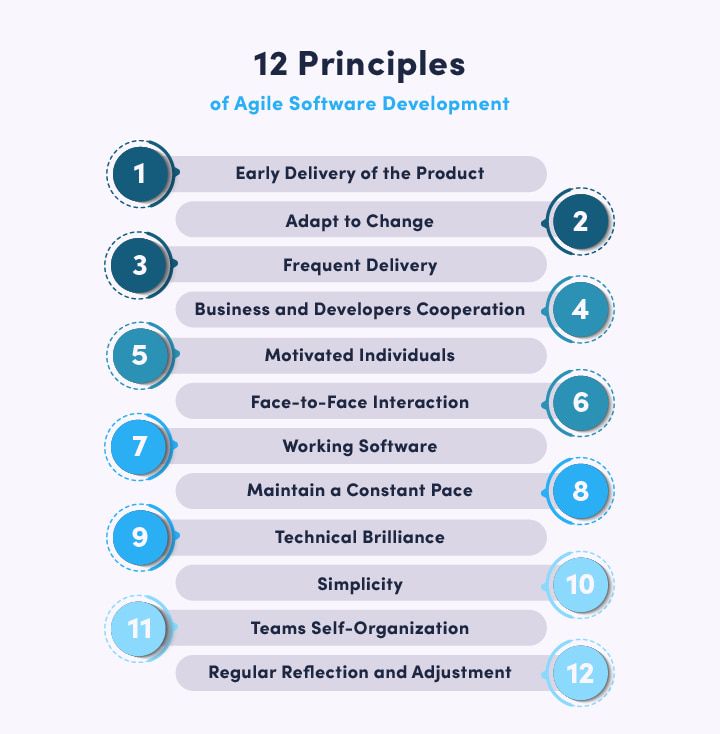
Agile Test Plan:
A Agile test plan incorporates kinds of testing done in that cycle like test information necessities, foundation, test conditions, and experimental outcomes. Dissimilar to the cascade model, in a Agile model, a test plan is composed and refreshed for each delivery. Normal test plans in Agile incorporates.
1. Testing Scope
2. New functionalities which are being tried
3. Level or Types of testing in light of the Features intricacy
4. Load and Performance Testing
5. Infrastructure Consideration
6. Mitigation or Risks Plan
7. Resourcing
8. Deliverables and Milestones
Agile Testing Strategies:
During the principal stage or cycle 0, you perform introductory arrangement assignments. It incorporates distinguishing individuals for testing, introducing testing apparatuses, planning assets (convenience testing lab), and so forth the accompanying advances are set to accomplish in Iteration 0.
a) Establishing a business case for the venture
b) Establish the limit conditions and the venture scope
c) Outline the vital necessities and use cases that will drive the plan compromises
d) Outline at least one up-and-comer models
e) Identifying the gamble
f) Cost assessment and set up a primer task
During the main stage or emphasis 0, you perform beginning arrangement assignments. It incorporates recognizing individuals for testing, introducing testing apparatuses, planning assets (convenience testing lab), and so on The accompanying advances are set to accomplish in Iteration 0.
a) Establishing a business case for the undertaking
b) Establish the limit conditions and the task scope
c) Outline the vital necessities and use cases that will drive the plan compromises
d) Outline at least one applicant designs
e) Identifying the gamble
f) Cost assessment and set up a fundamental undertaking
Construction Iterations:
Release End Game or Transition Phase:
A) The objective of “Delivery, End Game” is to send your framework effectively into creation. The exercises remembered for this stage are preparing end clients, supporting individuals, and functional individuals. Additionally, it incorporates promoting the item discharge, back-up, reclamation, conclusion of a framework, and client documentation.
B) The last Agile technique testing stage incorporates full framework testing and acknowledgment testing. In agreement to complete your last testing stage with practically no deterrents, you ought to need to test the item more thoroughly while it is in development cycles. During the final plan, analyzers will be chipping away at its deformity stories.
Production:
After the delivery stage, the item will move to the creation stage.
What is the Scope of Agile?
Item extension is every one of the elements and necessities that an item incorporates. Project degree is everything associated with making an item. … Light-footed activities, in any case, have a variable degree so that venture groups can right away and steadily fuse learning and input, and at last make better items.
Risk of Automation in Agile Process:
Advantage of Agile Methodology:
Given underneath are the different benefits of Agile Methodology:
Disadvantage of Agile Methodology:
However, there are a few benefits of the Agile system, there are sure hindrances associated with it as well. They are:
1) Comprehensive documentation isn’t favored which can prompt spry groups erroneously deciphering this as Agile doesn’t need documentation. So, the thoroughness gets lost on documentation. This ought to be tried not to by ceaselessly inquiring as to whether this is adequate data to continue or not.
2) Sometimes, toward the start of the activities, the prerequisites are not completely clear. The groups may continue and observe that the clients’ vision got realigned and, in such circumstances, the groups need to join many changes and it is challenging to check the final product too.
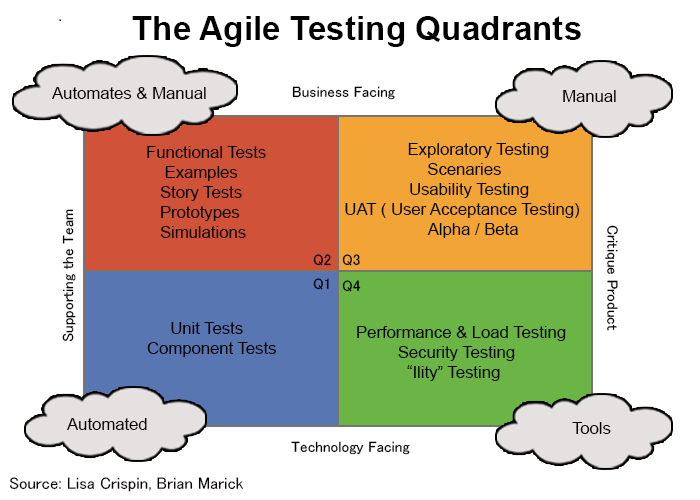
Pre-Requisites:
Before continuing with this instructional exercise, you want an essential information on programming advancement ideas like programming necessities, coding, testing, and so on.




